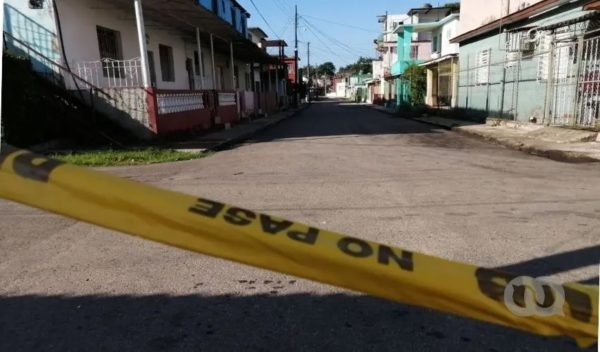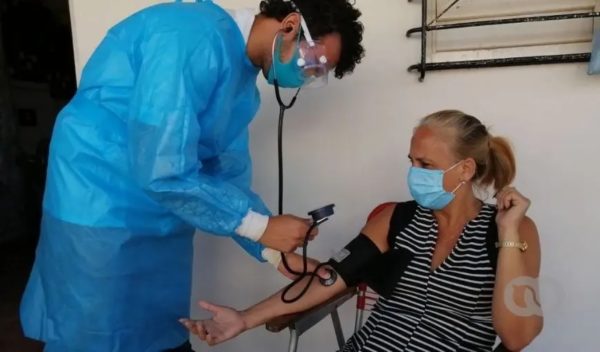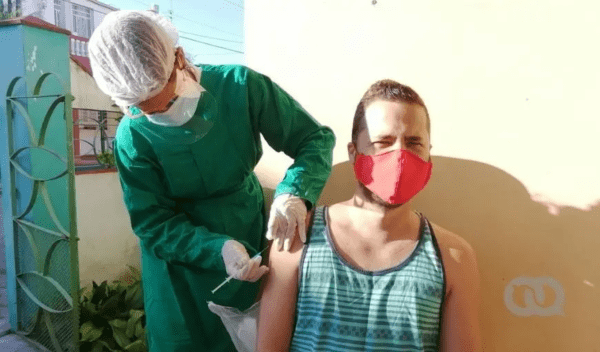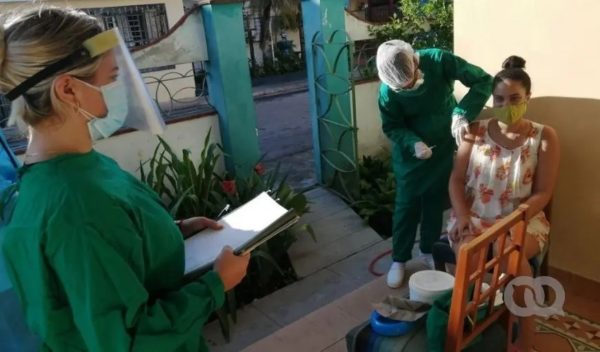The Last Applause: Stories from a Neighborhood in Lockdown

Text and photos by Ely Justiniani Perez (El Toque)
HAVANA TIMES – When the pandemic had still only recently hit the island, my block in the Villa Nueva neighborhood would go outside to applaud doctors, like they did in many other neighborhoods, at 9 PM. Moises would whistle, which worked as an alarm for everyone else to come out, but the clapping slowly died down and we stopped gathering in our doorways. The whistles stopped too. We were exhausted: of the restrictions, of this virus that has been around for going on two years. I didn’t hear the whistle again until Aixa returned from the isolation center. She was the first one of many to come back.
In late May 2021, it was announced that my block was under lockdown. It had become a kind of minefield where COVID-19 cases were detonating one after the other. Like with other outbreaks, the health authorities decided to stop people entering and leaving the block so as to contain the spread of the virus. There were nine people affected at the time, there would be seventeen infected in total.

It was Saturday morning when the doctor from the GP surgery came to announce that “they would close the block” that day at 5 PM. She asked for us to sort out essential things because she didn’t know how long the lockdown would last.
My first thought wasn’t oh no, am I infected or not? I was more worried about what we were going to eat, how we were going to survive. I went out to look for supplies as if we were about to go into war, while wondering how I was going to get everything I needed to stay at home for so long.
We live day to day here, and you don’t always manage to get the essentials: in addition to money, time, patience, a willingness to walk, you also need to stand in a line here, there, “invent” here or there. That was the challenge I had in front of me that Saturday at 11 AM, with the pressure of having to have everything ready for lockdown at 5 PM.
I gathered what I could. My neighbors did the same, who also complained to the authorities about this. They reassured us, we didn’t need to be worried; they told us that “conditions had been created for these cases” and that nobody would go hungry.
That night, Canal Habana TV showed a news report about a community in lockdown. The neighbors thanked the arrangements made by the municipal Government, who had set up retail points within the area with affordable prices, where you could see meat, fruit, vegetables and jams. My phone began to ring, it was a friend from the neighborhood who told me how relieved she was after watching that.
“Of course, we might even be able to eat a little bit of chocolate again,” I joked.
Jokes immediately began to fly from door to door: “If that’s the way things are going to be, let them lock us down for a while.” I preferred not to transmit my mistrust and suspicions that those “wonderful” lockdowns only happened in front of news cameras. I didn’t need to: we’d figure it out for ourselves.
The first days

At 5 PM, a convoy came to “establish the lockdown”: a representative from the provincial government, one from the municipal Public Health board and members of staff from the polyclinic who did the duty of cordoning us off with yellow tape from one end of the block to the other, in front of some curious neighbors. “We won’t lose our solemnity,” somebody close to me said.
A police officer was stationed at one of the corners, 24/7, and a “messenger” from another neigborhood was appointed to bring bread, products from the basic food basket and some packets of root vegetables, fruit or minced meat, which was sold during the first five days, out of the twenty-two we were in quarantine.
Lockdown is normally applied in Havana when more than ten neighbors test positive for COVID-19, whether they belong to the same family or not. According to protocols established by Havana’s Provincial Board of Public Health, the measure lasts for up to 10 days after the last person tests positive, although this isn’t the same for every region. The number of positive cases needed for lockdown varies in some places, other places decree a lockdown on the entire block, or two consecutive blocks. There can also be lockdowns with less than 10 positive cases, if the Rt number is high.
On the sixth day, we all had a PCR test done, which is given to ever member of the community during the first week, in order to identify cases. The results are almost always given by staff at the GP clinic in the area, or via the phone, calling the number 18826, an automated phone system where you can find out the status of your test after inserting your ID number.
Vaccination

Day 15 of our lockdown coincided with the date we were supposed to be given the first dose of the Cuban vaccine. Those of us who had tested negative in the previous PCR test and hadn’t been infected yet, asked local doctors for them not to delay the process. They agreed and, given the impossibility of us leaving the block, the medical team brought the Abdala vaccine to us.
At 8 AM on June 5th, the whole neighborhood was awake, putting chairs out in their doorways to wait for the medical staff, who would pass from home to home to take neighbors’ blood pressure before administering the vaccine. Neighbor reactions ranged from people asking to be left for last to see whether it hurt or not and delay it a little, to the people who joked that we were being injected with a “rosemary brew”.
The “brew” ended up being over 92% efficient against the virus; and nobody in the neighborhood had an adverse reaction to that first dose. One of the doctors stayed nearby for more than half an hour, in case there were any. We bid them farewell and thanked them for coming to us, and for the nurse’s kind hand, who helped us not notice the jab.

Only people who were kept at isolation centers are left to be vaccinated, or those who had suffered the virus at some point. According to the explanation given by medical staff at the GP’s office, the Abdala vaccine works by administering a certain viral load to the body, so that it can create antibodies to fight the disease. By becoming infected with the virus, the person receives the viral load and, as a result, should not receive another dose of the vaccine until after 40 days. The Abdala vaccine cycle is interrupted if a person becomes infected at some point, and Soberana Plus is administered after a certain period, which is considered more effective in these cases.
The applause
My block ended up having 17 positive cases, members of three families who became infected with the virus in different ways, without any apparent link between them. There weren’t any big slip-ups in most of the cases: there weren’t any parties or gatherings, people could have only been exposed at their jobs, on public transport or in the crowds in front of stores to buy cleaning and food products.
The first person to see somebody come back from the isolation center would begin to clap, and we would all come out, with the same enthusiasm as the first few days. Moises’ whistling came back. It was happy for us to see somebody come back healthy and safe.
Every case was different, but they were all a cause for concern in their own right: Maykol was only 3 years old when he became infected with his parents; Dely and her newborn baby of just a few weeks old; Aixza, who suffers from diabetes; Teresa, who is over 60 years old. Luckily, most people didn’t have any long-term effects and didn’t have anything more than a light cold; but not all cases were as lucky.
Sarahi was about five months pregnant when she became infected. She soon had shortness of breath and was classified as an “emergency” case soon after. Her lack of oxygen lasted for many weeks, to the point that doctors set a maximum date for her recovery: if she didn’t get better in that time, they would have to interrupt the pregnancy. I don’t know whether it was the prayers of her friends and husband or Sarahi’s determination to cling onto her child, but she slowly began to recover and respond to the treatment.
She was one of the first to leave home and one of the last to make it back. She was the one who scared and worried us the most. She was the one who received the most applause, along with a huge welcome back poster that her 8-year-old daughter had helped to make.

The final applause came on day 22 of our lockdown, after moments of joy, concern, gratitude for assistance, annoyance at some abuse or misinformation, after displays of solidarity between neighbors and nights of talking in doorways and bearing stress or boredom with heated debates. My neighborhood was like a mini country for almost a month, the only place I was able to access within a city and island that is still in lockdown. I hope to never experience anything like this again, but I’m happy I was able to share it with good people, with the best lockdown buddies you could hope for.





